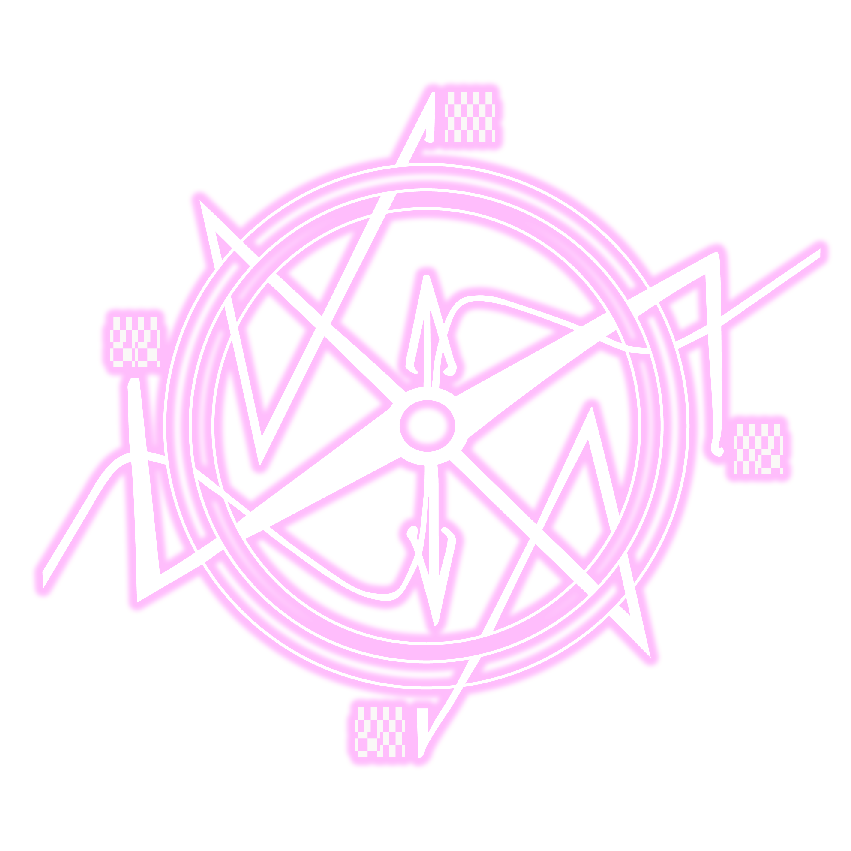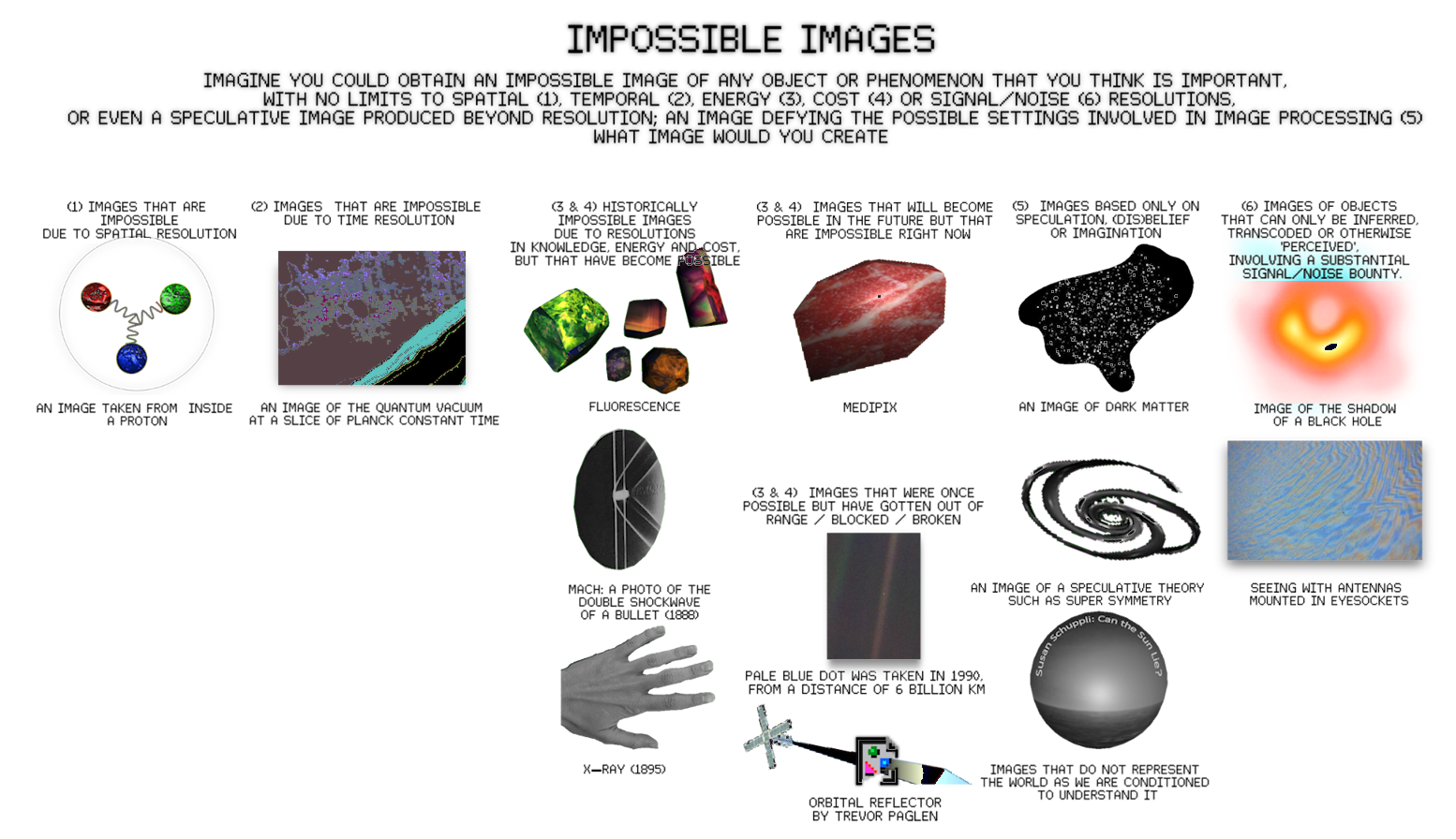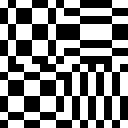
She collects limits embedded in the render pipeline, hoping these axes will seed a catalogue of compromised, unsupported, unknown or forgotten image renders:
a scanline, a separator, a progress bar, a ruler, a mesh, a vector, a link, a loop, ...a generator, a discriminator?
From her collection of lines, the Angel assembles a BLOb or Binary Large Object: an uncommitted form that dissolves hierarchy into ambiguous dimension.
The BLOb is best thought of as a fluid stack of shifting moiré; a living archive of all im/possible image pipelines.
In front of the BLOb, the Angel considers how resolutions consolidate technologies, while dictating constraints on how she cannot - or chooses not to - use them. They shape what she can render while foreclosing alternatives.
Her next mission is clear: map every limit in the image-processing pipeline and compile an Atlas of Destitute Vision, documenting how each resolution defines what remains unrendered and unseen.
She collects limits embedded in the render pipeline, hoping these axes will seed a catalogue of compromised, unsupported, unknown or forgotten image renders:
a scanline, a separator, a progress bar, a ruler, a mesh, a vector, a link, a loop, ...a generator, a discriminator?
From her collection of lines, the Angel assembles a BLOb or Binary Large Object: an uncommitted form that dissolves hierarchy into ambiguous dimension.
The BLOb is best thought of as a fluid stack of shifting moiré; a living archive of all im/possible image pipelines.
In front of the BLOb, the Angel considers how resolutions consolidate technologies, while dictating constraints on how she cannot - or chooses not to - use them. They shape what she can render while foreclosing alternatives.
Her next mission is clear: map every limit in the image-processing pipeline and compile an Atlas of Destitute Vision, documenting how each resolution defines what remains unrendered and unseen.
a scanline, a separator, a progress bar, a ruler, a mesh, a vector, a link, a loop, ...a generator, a discriminator?
From her collection of lines, the Angel assembles a BLOb or Binary Large Object: an uncommitted form that dissolves hierarchy into ambiguous dimension.
The BLOb is best thought of as a fluid stack of shifting moiré; a living archive of all im/possible image pipelines.
In front of the BLOb, the Angel considers how resolutions consolidate technologies, while dictating constraints on how she cannot - or chooses not to - use them. They shape what she can render while foreclosing alternatives.
Her next mission is clear: map every limit in the image-processing pipeline and compile an Atlas of Destitute Vision, documenting how each resolution defines what remains unrendered and unseen.

is a research project in the framework of my Arts at CERN COLLIDE Barcelona award.
curated by Monica Bello
.
If a myth is an algorithm that functions as a tool distinct to a time and place,then recursively, an algorithm can become a myth, written and transformed by iterative updates and within procedural contexts.
.
THE PARADOXES OF RESOLUTION ︎︎︎︎︎︎︎︎︎︎︎ ︎
Resolution as paradox / the paradoxes of resolution
The etymology of resolution can be traced to the Latin term re-solvere (“to loosen again”), which already frames it as a paradox. While today's general use of the term describes resolution as a fixed metric (lp/mm, PPI), its root refers to a process.
This tension implies its double state:
specification in the form of a number, preset, or artefactual residue.
a procedural mediation across the image ecology (capture, processing, compression, platform, reception)
Resolution studies reads images through this double lens: resolution as a process that negotiates constraints, and resolution as artefact that crystallises those negotiations into standards and traces - the features that make it legible as outcome.
The following paradoxes describe this move from resolution-as-process (constraints, methods, encodings) to resolution-as-artefact (from standard, to default and finally resolution as index).
The etymology of resolution can be traced to the Latin term re-solvere (“to loosen again”), which already frames it as a paradox. While today's general use of the term describes resolution as a fixed metric (lp/mm, PPI), its root refers to a process.
This tension implies its double state:
specification in the form of a number, preset, or artefactual residue.
a procedural mediation across the image ecology (capture, processing, compression, platform, reception)
Resolution studies reads images through this double lens: resolution as a process that negotiates constraints, and resolution as artefact that crystallises those negotiations into standards and traces - the features that make it legible as outcome.
The following paradoxes describe this move from resolution-as-process (constraints, methods, encodings) to resolution-as-artefact (from standard, to default and finally resolution as index).
0000 HOROLOGY
Progress as PenRose-Stairs to Nowhere
Every upgrade promises improvements, while manufacturing obsolescence and delaying final resolution. The gospel of progress is an endless loop.
0001 MATERIALITY
[Constraint]: Transmission as noise-dependent (Shannon, 1948)
There is no such thing as noise-free transmission. Noise embeds inflection. Optimisation can not delete noise; it moves it (in time, in frequency, in space, in perception).
Suppressing noise means engineering a cut-off. That choice decides what counts as detail and what is treated as fluctuation to discard. Every filter is a threshold.
Because noise makes the channel finite, optimisation is unavoidable.
There is no such thing as noise-free transmission. Noise embeds inflection. Optimisation can not delete noise; it moves it (in time, in frequency, in space, in perception).
Suppressing noise means engineering a cut-off. That choice decides what counts as detail and what is treated as fluctuation to discard. Every filter is a threshold.
Because noise makes the channel finite, optimisation is unavoidable.
[Method]: Optimisation as constraint (upgrade-as-limit / 1984)
Optimisation filters and sets stricter limits by implementing lower tolerances.
The more uniform a signal or expression, the more straightforward its message.
When selection is formalised as the encoding and decoding of data in storage and transport, it becomes compression.
[Encoding]: Compression as additive trace (deletion as design)
Compression doesn’t just reduce; it rewrites. Its resulting artefacts (pixels, lines, blocks, and so on) are codec- and preset-specific, and can therefore function as forensic fingerprints.
When a field agrees on codecs and bitrates, an optimisation or compression hardens into a standard. This move pivots resolution from technique to formalisation.
* Vernacular of File Formats
* Ecology of Compression Complexities (BY A BLOb)
Optimisation filters and sets stricter limits by implementing lower tolerances.
The more uniform a signal or expression, the more straightforward its message.
When selection is formalised as the encoding and decoding of data in storage and transport, it becomes compression.
[Encoding]: Compression as additive trace (deletion as design)
Compression doesn’t just reduce; it rewrites. Its resulting artefacts (pixels, lines, blocks, and so on) are codec- and preset-specific, and can therefore function as forensic fingerprints.
When a field agrees on codecs and bitrates, an optimisation or compression hardens into a standard. This move pivots resolution from technique to formalisation.
* Vernacular of File Formats
* Ecology of Compression Complexities (BY A BLOb)
0010 GENEALOGY
[Regime] Standardization as obfuscation (clarity via the omission of alternatives)
Standards create order by fixing baselines through calibration regimes. Visibility reflects what the system specifications are designed to render. What falls outside that baseline remains unrendered or misrendered.
To render one pathway means to erase another.
[Interface]: Obfuscation as transparency
Interfaces hide these exclusions to simulate a state of seamlessness. The interface feels transparent and immediate because layers of mediation are concealed.
Seamlessness is camouflage (the obfuscation of alternatives).
[Protocol]: Interoperability through exclusion (no protocol, no image)
Interoperability is rarely achieved through openness. Instead, it is constituted via enforced uniformity: inclusion via elimination, deprecation, and obsolescence. Protocols are policy written into code as standards, profiles, versions.
Parsable inputs are rendered; inadmissible ones are dropped, clipped, or voided. Interoperability is conditional on conformity: it is incompatibility is by design.
Standards create order by fixing baselines through calibration regimes. Visibility reflects what the system specifications are designed to render. What falls outside that baseline remains unrendered or misrendered.
To render one pathway means to erase another.
[Interface]: Obfuscation as transparency
Interfaces hide these exclusions to simulate a state of seamlessness. The interface feels transparent and immediate because layers of mediation are concealed.
Seamlessness is camouflage (the obfuscation of alternatives).
[Protocol]: Interoperability through exclusion (no protocol, no image)
Interoperability is rarely achieved through openness. Instead, it is constituted via enforced uniformity: inclusion via elimination, deprecation, and obsolescence. Protocols are policy written into code as standards, profiles, versions.
Parsable inputs are rendered; inadmissible ones are dropped, clipped, or voided. Interoperability is conditional on conformity: it is incompatibility is by design.
[Infrastructure]: Resolution as inherited compromise
(pipeline → stack → infrastructure)
Pipelines inherit compromises embedded in earlier architectures and defaults. These defaults reflect historic efficiency driven priorities, defining what, or whom, the system was originally built for.
What began as a pipeline (flow) calcified into a stack of dependencies that operate as infrastructure (rules and defaults that condition what can appear). While interfaces evolve, these exclusions persist: sedimented into infrastructure, obfuscated by default settings.
(pipeline → stack → infrastructure)
Pipelines inherit compromises embedded in earlier architectures and defaults. These defaults reflect historic efficiency driven priorities, defining what, or whom, the system was originally built for.
What began as a pipeline (flow) calcified into a stack of dependencies that operate as infrastructure (rules and defaults that condition what can appear). While interfaces evolve, these exclusions persist: sedimented into infrastructure, obfuscated by default settings.
[Epistemic]: Selective capture as ground truth
The same logic governs what is is captured. Standards, priors, and curation set thresholds of relevance: what counts as a signal, what is dismissed as noise. This selective perception fabricates an epistemic “truth” mistaken for objectivity; it doesn’t just limit resolution, it defines what can be resolved, or what is measurable, thinkable, and rendered real.
0100 SCALE
[Scale as phenomenology]: Perception as failure
Standardised imaging systems don’t scale neutrally; they impose thresholds of legibility that decide what remains visible and what disappears. Scaling is a politics of admissibility and access.
Spectral: Narrow bands flatten distinctions; excessive bands oversaturated the ability to distinguish (whiteout).
Spatial/temporal scale: At micro-scale, detail fragments into “noise”; at macro-scale, meaning dissolves into abstraction. More data doesn’t mean more understanding.
[Semiosis] Resolution as index (artefact as carrier of meaning)
Legacy resolutions (visible as artefacts) collect meaning beyond their function: they become cues of authenticity, nostalgia, or proof. Defaults harden into signs; residues turn into reference or index.
Process has now ossified in residue, and residue has become meaning.
* FF D8 De/Calibration Target Standardised imaging systems don’t scale neutrally; they impose thresholds of legibility that decide what remains visible and what disappears. Scaling is a politics of admissibility and access.
Spectral: Narrow bands flatten distinctions; excessive bands oversaturated the ability to distinguish (whiteout).
Spatial/temporal scale: At micro-scale, detail fragments into “noise”; at macro-scale, meaning dissolves into abstraction. More data doesn’t mean more understanding.
[Semiosis] Resolution as index (artefact as carrier of meaning)
Legacy resolutions (visible as artefacts) collect meaning beyond their function: they become cues of authenticity, nostalgia, or proof. Defaults harden into signs; residues turn into reference or index.
Process has now ossified in residue, and residue has become meaning.
0101 CRISIS
[Process] Resolution as process (the image is non-static)
A resolution is data-in-process; a state produced by limits, filters, bends, and breaks imposed by governing protocols. Resolution never resolves in a final image.
Instead, it is a momentary myth crystallised by procedural progress, an algorithm deployed in a specific time and place.
RESOLUTION DISPUTES
While the institutions of Resolution Disputes (i.R.D., 2015) formalized a foundational set of logics structuring inherited systems of image rendering, the entries in the Atlas of Destitute Vision trace newly encountered Resolution Disputes: paradoxes that arise from the Angel’s mapping of failure, oversaturation, illegibility, and compromise.
Paradigm shifts in the phases of the image,
or the additive crisis of the image
0. OBSOLESCENCE OF ANALOG IMAGE PROCESSING TECHNOLOGIES
1. TRANSITION FROM ANALOG TO DIGITAL IMAGE PROCESSING
2. PLATFORMED/NETWORKED IMAGE
3. CRISIS OF THE SYNTHETIC/HYPER IMAGE
* BLOb of im/possible Images
Resolution studies, classes and seminars
Resolution Studies is grounded in practical teaching and artistic research. It currently involves seven thematic “disputes,” each addressing a fundamental tension within the study of rendering, image culture, and media infrastructure:
Each dispute opens a terrain of theoretical and material exploration, inviting research, pedagogy, and speculative practice.
>>> For a deeper theoretical framing, see the long-form essay:
Refuse to let the syntaxes of (a) history direct our futures. [PDF]
